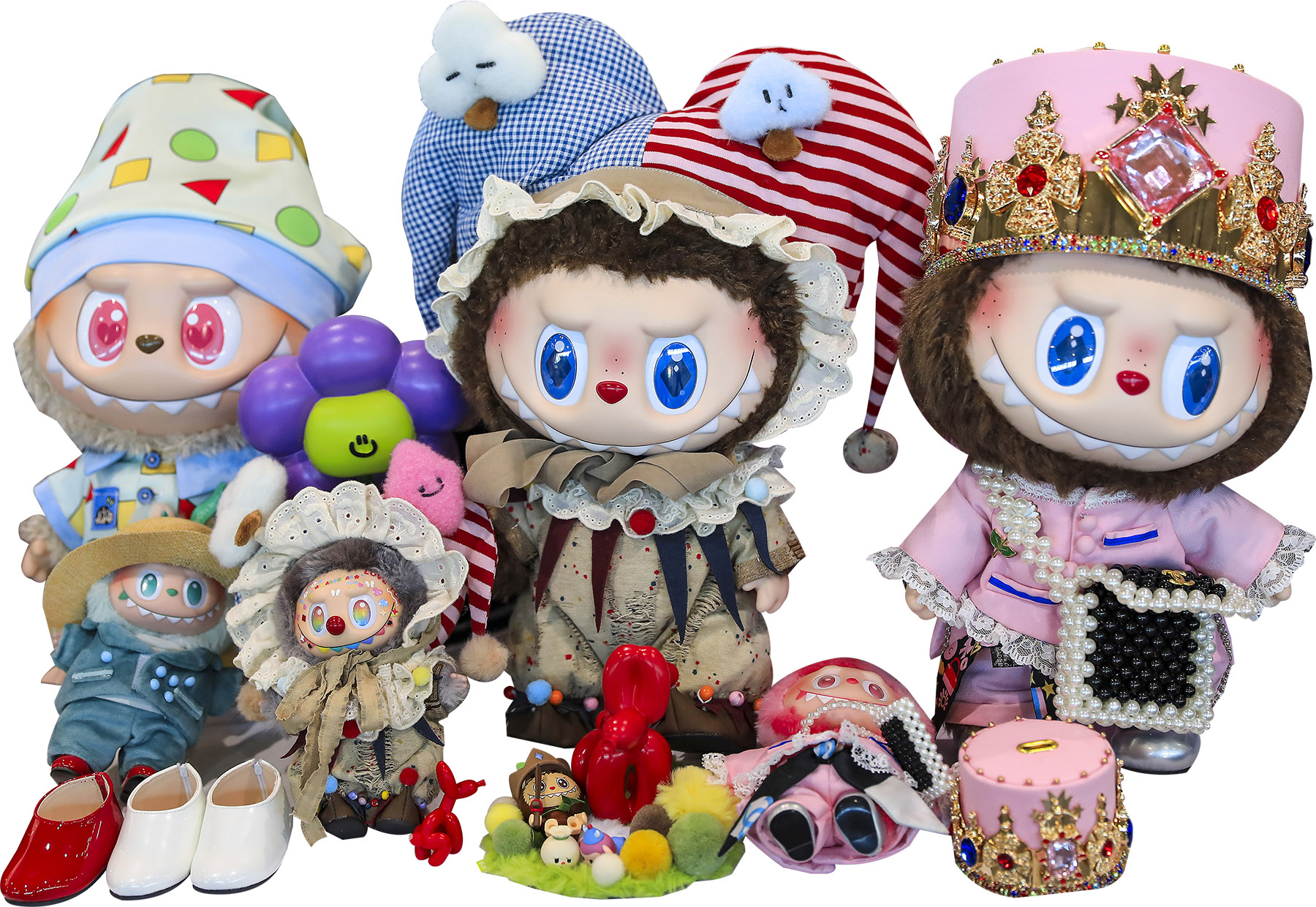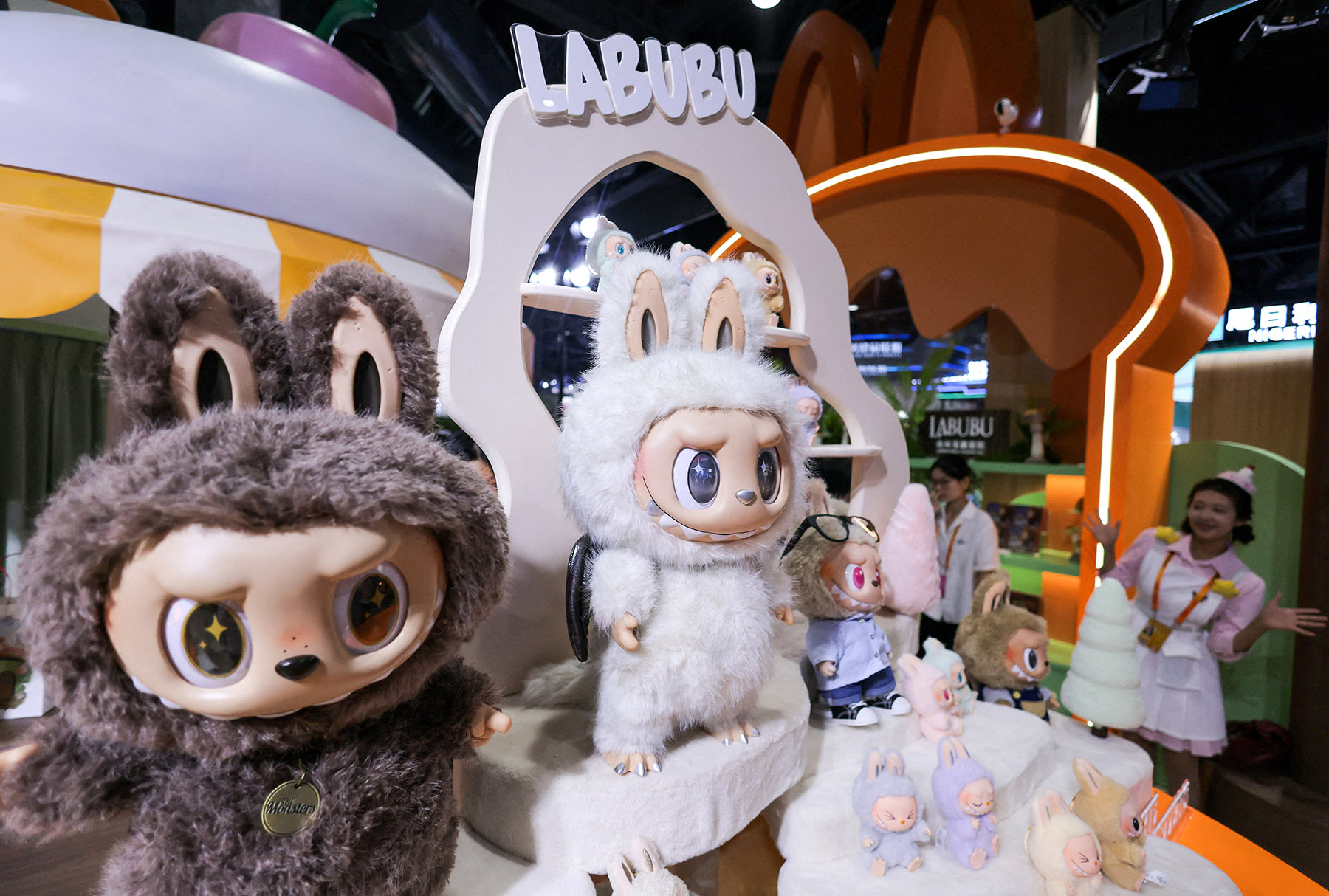In manufacturing hubs across Jiangsu and Zhejiang provinces, garment factories for such mini companions now dominate production

Mini suits, pants, hanfu (traditional Chinese clothing), Victorian dresses — these aren't children's clothes nor costumes, but "doll outfits" that young Chinese adults collect for their figurines.
From Disney's LinaBell to Pop Mart's Labubu, each viral character has become a fashion phenom, igniting what consumers now call the "doll-dress economy". Once a niche hobby, the trend is booming into a striking new cornucopia of youth consumption.
Labubu, part of Pop Mart International Group's blind-box celebrity characters, has become a breakout success across China and around the world. Known for their "unboxing surprise "appeal and quirky lore, the characters have spawned a spin-off industry in miniature fashion — knit headbands a few centimetres wide, denim jackets just a handspan long, and even tiny leather backpacks. Fans have curated wardrobes to personalize their figures, often treating them as companions.
Search "Labubu doll clothes "on major e-commerce platforms and thousands of shops pop up. Basics such as plaid skirts or hoodies go for 16-40 yuan ($2-5), mid-tier embroidered hanfu or lined coats are sold for 100-200 yuan, while high-end limited pieces or replicas of celebrity costumes can exceed 200 yuan. Collectors willingly pay for scarcity and exclusivity.
READ MORE: Unveiling the 'Dolliverse'
For Sharon Han, a 30-year-old office worker in Beijing, doll fashion is about more than clothing the mini companions as she purchases a set of cowboy jeans for her Labubu figurine.
"Dressing them and caring for them gives me a sense of ownership," she said. "They can even match my bags and my dressing styles."
The surge reflects the power of "emotional value".
"Doll clothes embody this — they're stress-relief toys, social icebreakers and emotional anchors," Han said, adding that she quickly finds community through her hobby.
"With doll clothes I instantly meet like-minded friends. It breaks the ice."
Behind the frenzy is the country's agile supply chain, capacity in churning out rapid, small-batch customization. That makes doll fashion a new growth avenue for traditional apparel firms stuck in cutthroat competition.

In manufacturing hubs across Jiangsu and Zhejiang provinces, garment factories now dominate doll-clothing production, leveraging their craftsmanship and supplier networks. Some workshops have even integrated fabrics such as silk into miniature designs, reviving traditional techniques in pocket-sized form. For many, the shift represents a leap from low-margin contract work to high-margin original design.
Sales data reflect the surge. Doll-clothing sales were up 117 percent in 2024 from a year earlier on e-commerce platforms, with a sharp spike in May 2025, according to a report by CCTV Finance.
In Yiwu, Zhejiang province, the wholesale hub's orders from North America, Japan and South Korea are multiplying. Reorder rates between March and May were especially strong, suggesting full-year sales could beat expectations.
The boom is not without risks. On resale platforms, prices for Labubu's Lucky & Hope figures have plunged more than 70 percent since June. Lucky dropped from 600 yuan to 133 yuan, while Hope fell from 450 yuan to 108 yuan by Sept 11.
The fall reflects a supply shift. Pop Mart heavily restocked inventory during China's June 18 shopping festival, with July-September supplies estimated at two to three times earlier levels. The company also boosted monthly output of Labubu plush vinyl figures to 30 million — about 10 times first-quarter volumes.
JPMorgan Chase recently downgraded Pop Mart to neutral, citing an absence of catalysts and stretched valuations. Analysts flagged weaker resale premiums for mini Labubu figures as a sign of cooling fundamentals.
Data show the resale premium for Pop Mart's 14-piece mini Labubu blind box has dropped 24 percent from its prelaunch peak in just two weeks. Pop Mart attributed the decline partly to higher volume, noting the first batch alone reached around one million units — well above previous series tallies.
ALSO READ: An elf that does not toy with adults
Despite recent volatility, Pop Mart's long-term trajectory remains tied to the fusion of licensed IPs and fast execution. According to Euromonitor International, this combination has enabled the company to scale rapidly, though momentum naturally ebbs and flows with IP cycles and regulatory shifts.
"Much of Pop Mart's success is connected with cultural trends and online virality," Euromonitor said. "Speed is its core advantage, but future growth may require more diversification beyond concentrated IP bets."
The company is already experimenting. Its new mini Labubu series makes one of its strongest characters more accessible through smaller, lower-priced figures. The move broadens the consumer base and opens lifestyle crossover potential through accessories and portable designs.
Early sell-outs suggest a strong reception. Euromonitor said the format could support both domestic expansion and international growth. Still, careful pacing of releases and a focus on quality will be critical to maintain collector enthusiasm and brand equity.
Contact the writer at wangzhuoqiong@chinadaily.com.cn


